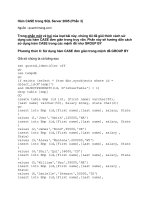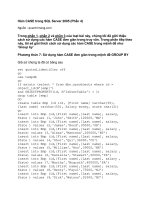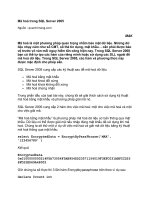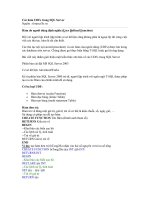tài liệu chỉ mục trong sql server
Bạn đang xem bản rút gọn của tài liệu. Xem và tải ngay bản đầy đủ của tài liệu tại đây (174.96 KB, 31 trang )
Storing Data: Disks and Files
Disks and Files
DBMS stores information on (“hard”) disks.
This has major implications for DBMS design!
READ: transfer data from disk to main memory
(RAM).
WRITE: transfer data from RAM to disk.
Both are high-cost operations, relative to inmemory operations, so must be planned
carefully!
Why Not Store Everything in Main
Memory?
Costs too much. With the same cost, we
can by a disk which has storage capacity
greater in comparing to buying ram.
Main memory is volatile. We want data to
be saved between runs. (Obviously!)
Typical storage hierarchy:
Main memory (RAM) for currently used data.
Disk for the main database (secondary storage).
Tapes for archiving older versions of the data
(tertiary storage).
Disks
Secondary storage device of choice.
Main advantage over tapes: random
access vs. sequential.
Data is stored and retrieved in units
called disk blocks or pages.
Unlike RAM, time to retrieve a disk page
varies depending upon location on disk.
Therefore, relative placement of pages on
disk has major impact on DBMS performance!
Components of a Disk
Disk head
The platters spin (say, 90rps).
The arm assembly is
moved in or out to
position a head on a
desired track. Tracks
under heads make a
cylinder
(imaginary!).
Only one
head
Sector
reads/writes at any
one time.
Arm movement
Arm assembly
Block size is a multiple
of sector size (which is
fixed).
Spindle
Tracks
Platters
Accessing a Disk Page
Time to access (read/write) a disk block:
Seek time and rotational delay dominate.
seek time (moving arms to position disk head on track)
rotational delay (waiting for block to rotate under head)
transfer time (actually moving data to/from disk surface)
Seek time varies from about 1 to milliseconds (msec)
Rotational delay varies from 0 to 10msec
Transfer rate is about 1msec per 4KB page
Key to lower I/O cost: reduce seek/rotation
delays! Hardware vs. software solutions?
Arranging Pages on Disk
`Next’ block concept:
blocks on same track, followed by
blocks on same cylinder, followed by
blocks on adjacent cylinder
Blocks in a file should be arranged
sequentially on disk (by `next’), to
minimize seek and rotational delay.
For a sequential scan, pre-fetching
several pages at a time is a big win!
RAID (Redundant arrays of independent
disks)
The performance of microprocessors has
improved at about 50 percent or more per
year, but disk access times have improved at
a rate of about 10 percent per year and disk
transfer rates at a rate of about 20 percent
per year: Disks are potential bottle necks for
system performance and storage system
reliability
In addition, since disks contain mechanical
elements, they have much higher failure rates
than electronic parts of a computer system. If
a disk fails, all the data stored on it is lost
RAID
Disk Array: Arrangement of several disks that gives
abstraction of a single, large disk.
Goals: Increase performance and reliability of the
resulting storage system.
Two main techniques:
Performance is increased through data striping: the
data is segmented into equal-size partitions that are
distributed over multiple disks; size of a partition is
called the striping unit.
Reliability is improved through redundancy: More
disks more failures, redundant information is
maintained. Redundant information allows reconstruction
of data if a disk fails.
RAID:
a combination of data striping and
redundancy.
RAID Levels
Several RAID organizations, referred to as RAID
levels, have been proposed. Each RAID level
represents a different trade-off between reliability
and performance. Those have become industry
standards
Level 0: Uses data striping, no redundancy
Level 1: Mirrored (two identical copies), no striping
Each disk has a mirror image (check disk)
Parallel reads, a write involves two disks.
Maximum transfer rate = transfer rate of one disk
Level
0+1: Striping and Mirroring
Parallel reads, a write involves two disks.
Maximum transfer rate = aggregate bandwidth
RAID Levels (Contd.)
Level 3: Bit-Interleaved Parity
Level 4: Block-Interleaved Parity
Striping Unit: One bit. One check disk.
Each read and write request involves all disks;
disk array can process one request at a time.
Striping Unit: One disk block. One check disk.
Parallel reads possible for small requests, large
requests can utilize full bandwidth
Writes involve modified block and check disk
Level 5: Block-Interleaved Distributed Parity
Similar to RAID Level 4, but parity blocks are
distributed over all disks
Disk Space Management
Lowest layer of DBMS software manages
space on disk.
Higher levels call upon this layer to:
allocate/de-allocate a page
read/write a page
Request for a sequence of pages must be
satisfied by allocating the pages sequentially
on disk! Higher levels don’t need to know how
this is done, or how free space is managed.
Buffer Management in a
DBMSPage Requests from Higher Levels
BUFFER POOL
disk page
free frame
MAIN MEMORY
DISK
DB
choice of frame dictated
by replacement policy
Data must be in RAM for DBMS to operate on it!
Table of <frame#, pageid> pairs is maintained.
When a Page is Requested ...
If requested page is not in pool:
Choose a frame for replacement
If frame is dirty, write it to disk
Read requested page into chosen frame
Pin the page and return its address.
If requests can be predicted (e.g., sequentia
pages can be pre-fetched several pages at a
☛
More on Buffer Management
Requestor of page must unpin it, and
indicate whether page has been
modified:
dirty bit is used for this.
Page in pool may be requested many
times,
a pin count is used. A page is a candidate
for replacement iff pin count = 0.
DBMS vs. OS File System
OS does disk space & buffer management:
why not let OS manage these tasks?
Differences in OS support: portability issues
Some limitations, e.g., files can’t span disks.
Buffer management in DBMS requires ability
to:
pin a page in buffer pool, force a page to disk
(important for implementing CC & recovery),
adjust replacement policy, and pre-fetch pages
based on access patterns in typical DB operations.
Record Formats: Fixed
Length
F1
L1
Base address (B)
F2
F3
F4
L2
L3
L4
Address = B+L1+L2
Fi: field i
Information about field types same for all
records in a file; stored in system catalogs.
Finding i’th field does not require scan of
record.
Record Formats: Variable
Length
Two alternative formats (# fields is fixed):
F1
4
Field
Count
F2
$
F3
$
F4
$
$
Fields Delimited by Special Symbols
F1
F2
F3
F4
Array of Field Offsets
☛ Second offers direct access to i’th field, efficient stora
of nulls (special don’t know value); small directory overh
Page Formats: Fixed Length
Records
Slot 1
Slot 2
Slot 1
Slot 2
...
Slot N
Free
Space
...
Slot N
Slot M
Page
N
1 . . . 0 1 1M
header
M ... 3 2 1
number
PACKED
of records
UNPACKED, BITMAP
☛
an array of
bits: if bit is
turned on
then a record
is located on
the
correspondin
g slot
number
of slots
Record id =
alternative, moving records for free space
management changes rid; may not be acceptable.
Page Formats: Variable Length
Records
Rid = (i,N)
Page i
Rid = (i,2)
Rid = (i,1)
20
N
16
...
SLOT DIRECTORY
☛
24 N
2
# 1slots
Pointer
to start
of free
space
Can move records on page without changing
rid; so, attractive for fixed-length records too.
Files of Records
Page or block is OK when doing I/O, but
higher levels of DBMS operate on records,
and files of records.
FILE: A collection of pages, each containing a
collection of records. Must support:
insert/delete/modify record
read a particular record (specified using record
id)
scan all records (possibly with some conditions
on the records to be retrieved)
Unordered (Heap) Files
Simplest file structure contains records in no
particular order.
As file grows and shrinks, disk pages are
allocated and de-allocated.
To support record level operations, we must:
keep track of the pages in a file
keep track of free space on pages
keep track of the records on a page
There are many alternatives for keeping track
of this.
Heap File Implemented as a
List
Data
Page
Data
Page
Data
Page
Full Pages
Header
Page
Data
Page
Data
Page
Data
Page
Pages with
Free Space
The header page id and Heap file name must
be stored someplace.
Maintaining a doubly linked list of pages with
free space and a doubly linked list of full pages.
Heap File Using a Page
Directory
Data
Header
Page
Page 1
Data
Page 2
DIRECTORY
Data
Page N
The entry for a page can include the
number of free bytes on the page.
The directory is a collection of pages; linked
list implementation is just one alternative.
Much smaller than linked list of all HF pages!
Indexes
An index is an auxiliary data structure that is
intended to help us find rids of records that
meet a selection condition
Indexes in a Library









